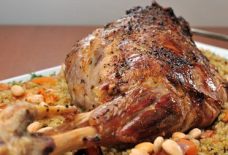Tanneries, Cloths and Dyeing in the Arab World
By: Lindsey Penn/Arab America Contributing Writer
The Arab world is well known for its leatherwork, dye, and cloths. Their traditions surrounding leather and cloth go back to thousands of years ago. They have still managed to keep many of these traditions alive, despite the manufacturing boom and the widespread use of factories. Using leather for garments, shoes, and containers goes back thousands of years. Once people discovered that leather could protect their feet and bodies from the elements and can be used for storing goods like water, the use of leather increased.
Methods for Tanning Leather
Many places have different methods for tanning leather, but in places such as Morocco, traditional tanneries have stayed in use. Part of what makes Morocco unique is because its method-the process of tanning leather remains completely done by hand. Typically, goats, sheep, and camel hides are the most common, although they do use cowhides occasionally.
The first step in traditional Moroccan tanneries is to wash the skin with salt to dry it out, then they coat the leather in a paste made from limestone. This paste makes the leather supple and soft, something that Moroccan leather is well-known for. The hides, once cleaned, are left to dry for two weeks. Once the two weeks are up, the leather is put into vats of guano (excrement from birds). This step is what causes the smell that a lot of real leather products have. After putting the hides in the bird droppings, they are hung out to dry. The final step is to scrape the hides to remove any leftover hair. Once the whole process is complete, the tanner sells the hides to dyers and crafters.
Dyeing Leather
When the leather is sold to the dyers, the dyers use a method of natural vegetable dyeing. This means that the colors are created from plants and are natural. They can dye the leather to just about any color, including bright red (red poppy), pink (rose), orange (henna), black (henna and sugar), blue (indigo), green (mint), and yellow (pomegranate mixed with saffron). Each dye is made in a stone vessel that is about four feet wide, and each vessel has a specific smell because of the ingredients for the dye. The leather is soaked in the dye until it takes on the color.
From there, the leather can be made into anything, although most commonly it is shoes and handbags. The leather can be stamped with patterns, sewn into shapes, and more before being sold.
Textiles in the Arab World
The Arab world is also famous for its textile industry, ranging from exports to producing clothing. Starting hundreds of years ago, there are records showing flax for linen being exported by Egypt, raw cotton being shipped from Syria and Egypt, and silk sent from Syria and Iran. Many clothes from the Arab world are beautifully woven and dyed, garnering admiration from people around the world. Throughout the Arab world, there are also different styles of textiles. For example, the Moroccan Amazigh have their own style, and then there is the kilim style, common throughout the Middle East and Central Asia.
The Moroccan Amazigh textiles have different patterns based on the different tribes. That being said, though, most of them are made of wool and basically, all of them are handwoven. Some of the patterns are geometric (incorporating stars and diamonds), while others have sequins or are hand-embroidered. The Amazigh culture holds a special place for textiles, as many different types (blankets, clothing, etc.) have a special meaning. One example of this would be a wedding blanket, woven by the bride’s family, and given to the married couple to bring good luck.
Kilim textiles are typically rugs made from wool. They can have so many different designs, although geometric designs are the most common, as they are easier to create. These textiles can also be very colorful.
Dyeing Cloth
Similarly to dyeing leather, textiles can be dyed using natural ingredients. Indigo, for example, is a popular dye for blue. It was used a lot in ancient Egypt and continues to be so popular today that people have found a way to create the artificial indigo dye. The Ottomans also used indigo to create red or purple colors by combining it with other ingredients cochineal (creating a purple color). Other natural dyes include the madder plant (red, also used a lot in ancient Egypt), turmeric (yellow), saffron (also yellow), and some types of shellfish (royal purple).
Check out Arab America’s blog here!








